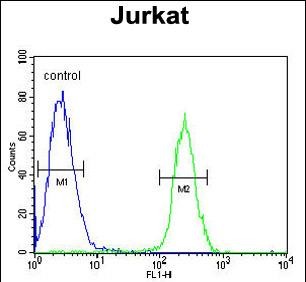产品名称
RNF8 Rabbit Polyclonal Antibody
别名
E3 ubiquitin-protein ligase RNF8, hRNF8, 632-, RING finger protein 8, RNF8, KIAA0646
Human Gene ID
NP_003949.1;NP_898901.1
Human Swissprot No.
O76064
特异性
This RNF8 antibody is generated from rabbits immunized with recombinant protein of human RNF8.
稀释度
WB~~1:1000;FC~~1:10~50
背景介绍
RNF8 contains a RING finger motif and a FHA domain. This protein has been shown to interact with several class II ubiquitin-conjugating enzymes (E2), including UBE2E1/UBCH6, UBE2E2, and UBE2E3, and may act as an ubiquitin ligase (E3) in the ubiquitination of certain nuclear proteins.
组织表达
Ubiquitous. In fetal tissues, highest expression in brain, thymus and liver. In adult tissues, highest levels in brain and testis, lowest levels in peripheral blood cells
细胞定位
Nucleus {ECO:0000255|HAMAP-Rule:MF_03067, ECO:0000269|PubMed:11322894, ECO:0000269|PubMed:14981089, ECO:0000269|PubMed:16215985, ECO:0000269|PubMed:23233665}. Cytoplasm {ECO:0000255|HAMAP-Rule:MF_03067}. Midbody {ECO:0000255|HAMAP- Rule:MF_03067}. Chromosome, telomere {ECO:0000255|HAMAP-Rule:MF_03067} Note=Recruited at uncapped telomeres (By similarity). Following DNA damage, such as double-strand breaks, recruited to the sites of damage (PubMed:18001824, PubMed:18077395, PubMed:22266820, PubMed:23233665) During prophase, concomitant with nuclear envelope breakdown, localizes throughout the cell, with a dotted pattern. In telophase, again in the nucleus and also with a discrete dotted pattern in the cytoplasm. In late telophase and during cytokinesis, localizes in the midbody of the tubulin bridge joining the daughter cells. Does not seem to be associated with condensed chromosomes at any time during the cell cycle. During spermatogenesis, sequestered in the cytoplasm by PIWIL1: RNF8 is released following ubiquitination and degradation of PIWIL1 {ECO:0000255|HAMAP-Rule:MF_03067, ECO:0000269|PubMed:18001824, ECO:0000269|PubMed:18077395, ECO:0000269|PubMed:22266820, ECO:0000269|PubMed:23233665}
纯化
Purified polyclonal antibody supplied in PBS with 0.09% (W/V) sodium azide. This antibody is purified through a protein A column, followed by protein affinity purification.


